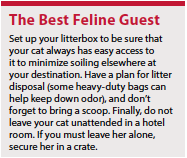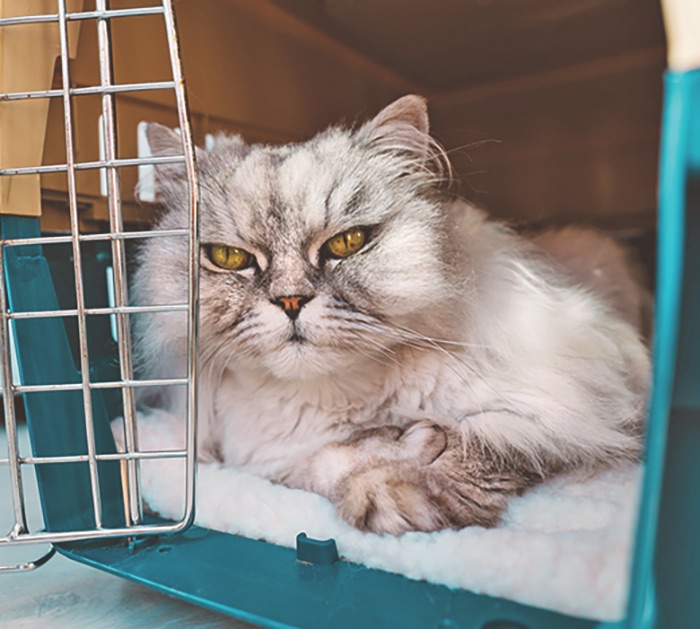You’ve got that right—we’re talking crate training your cat. Crates and carriers aren’t just for dogs!
The ways that a crate can be useful for life with your cat include:
- Containment when doors will be open
- Easier trips to the veterinarian
- Determining which cat has diarrhea
- Prevention of destructive behavior
- Private spot for litterbox
- Safe, less stressful travel
Choosing a Crate or Carrier
The size and type of crate or carrier you need for your cat will depend on how you plan to use it. “For containment at home, a large 24 x 36 inch dog crate that can accommodate a litterbox, food and water bowls, and a perch usually works well”, says Kate Basedow, LVT, Cornell College of Arts and Sciences class of 2013.
A plastic or wire crate provides the most security, but lighter fabric crates can be a convenient option as well when you’re traveling and can watch her. If your cat tends to be a heavy scratcher, avoid fabric crates. Top doors can make loading your cat up easier.
A crate is especially important for traveling with your cat, so it’s important that she be comfortable in the crate before you also introduce her to a new home or hotel. “Cats tend to hunker down and hide when in a new place,” says Basedow, who has been a licensed veterinary technician for four years. “You don’t want to ‘lose’ your cat in a strange house or a hotel suite because she is in hiding mode. Setting her up in a crate with everything she needs gives her a sense of security, especially if you put a blanket over it so it feels like a cave, but also ensures that you know where she is.”
 In the car, however, you might not have as much space. This is where cat carriers shine. Choose a carrier that is big enough for your cat to lie down and turn around comfortably, and a style that appeals to you both. Consider an airline-approved carrier for the most security.
In the car, however, you might not have as much space. This is where cat carriers shine. Choose a carrier that is big enough for your cat to lie down and turn around comfortably, and a style that appeals to you both. Consider an airline-approved carrier for the most security.
How to Crate Train Your Cat
“Most cats adjust to a large crate or kennel very readily,” says Basedow. “Some might vocalize a bit, but usually it isn’t a big deal. If you adopted your cat from a shelter or rescue, she has likely already been in a kennel of some sort and is used to that layout. If you’ve taken in a stray from outside, she might be more antsy, but the crate will also provide her with a safe den.”
Introducing your cat to a carrier can be a little trickier because they are so small (especially the doors).
“Just stuffing your cat in is NOT the way to go,” says Basedow. “You might succeed the first time, but the next time your cat sees the carrier she is likely to put up a fight. Make it positive! Leave the carrier open in a convenient spot in your house so that it smells like home, rather than the garage or basement, and your cat can explore it freely. Putting special treats in there for your cat to find is another great way to make her associate the carrier with positive things.”
Traveling With Your Cat
Cats don’t like change, so traveling isn’t usually high on their list of fun activities. With practice, though, you can make road trips pleasant for your cat. Some cats do fine in the car, but others drool or vocalize. Take short practice drives around your neighborhood. Using a cat pheromone product like Feliway can also help to calm your cat in the car. If your cat continues to be distressed or nauseous after several practice drives, ask your veterinarian about medications to help your cat relax on the big trip.
Things to bring when traveling with your cat include:
- Bowls
- Carrier for in the car
- Collar or harness with identification
- Extra blankets or towels
- Food
- Larger crate to use at your destination (if needed)
- Litterbox and the litter that your cat is used to (don’t forget a scooper!)
- Medications (if applicable)
- Vaccination records
- Water (some cats dislike water that tastes different)
Safety When Traveling
Your cat should always be in a carrier when riding in a car. This will keep her secure in case of an accident and prevents her from interfering with the driver or darting out a door or window.
Kitty should wear a collar and/or harness with your phone number on it. Ideally, your cat will never get loose in the first place, but if she does this identification will help her get back to you faster if a good Samaritan takes her in. Microchipping is also a great way to be sure that your cat can be identified in case of an escape.
Keep in mind that cats can behave unpredictably in a new environment. Usually, their first instinct is to hide. In addition to hiding, your cat might try to dart through doors. Be mindful of where your cat is when opening a door, especially if it opens to the outside.
Consider bringing a crate to set up as a “kitty condo” in the hotel room to keep your cat secure and within reach.
Have Fun
Don’t forget to have a little fun with your feline friend! Bring her favorite toys and give her some one-on-one attention each day of the trip just like you would at home. Playing also burns some energy, which will help your cat to rest calmly when she needs to be in her carrier. If your cat is too nervous to play, that’s okay. Just cuddle with her and tell her what a great job she’s doing.




